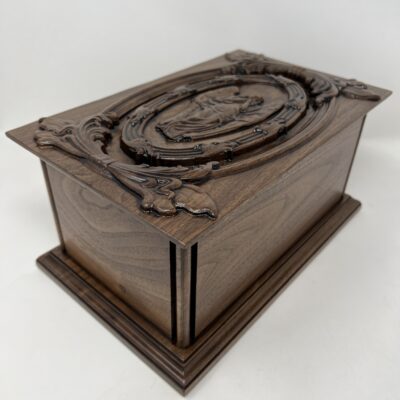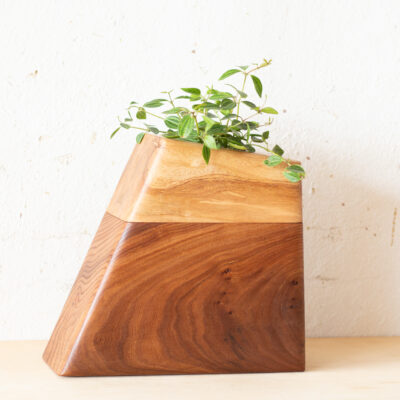You may have heard the term “cremains” and wondered what it is and where it came from. We’re here to help you find out!
Cremains Definition
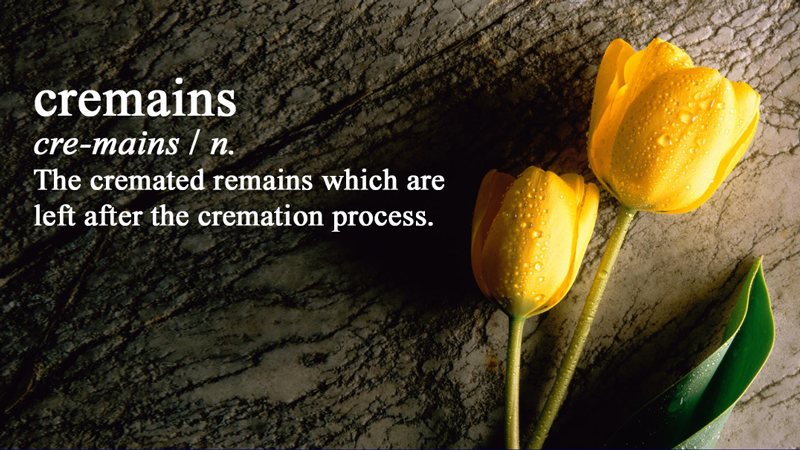
Cremains are the bone fragments from a cremated body which remain after the cremation process.
The term “cremains” is a portmanteau, a blending of words which combines “cremated remains.” While commonly referred to as “ashes,” technically cremains are not ashes but rather mostly dry calcium phosphates with some various minor minerals such as salts of sodium and potassium, or more simply, bone matter.
Since the cremation process takes place using extreme temperatures upwards of 1600° F, any true ash is completely incinerated.
Occasionally there are additional non-organic materials such as plates, screws, or pins from surgery, dental fillings, missed jewelry, or metal surgical implants such as hip replacements. These are removed by the crematorium staff after the cremation process by passing a magnet over the cremains.
The remaining bone material then passes through a processor which grinds the remains into a fine powder. This powder, which is commonly mistaken for ash, is then placed into a plastic bag inside a temporary plastic or cardboard urn box and passed on to the funeral director or family of the deceased.
Is Cremains a Real Word?
Yes and no.
No, cremains is not a “real” word because it was simply made-up and gets limited usage even within the funeral industry. For a time, there was an idea amongst funeral professionals that we needed specialized terms, perhaps to help undergird and validate the authority of the professionals as “experts.” Someone combined the term “cremated remains” to make up a new word, and “cremains” has lingered around ever since.
Yes, it is a real word in the sense that it does get used and has entries in the online dictionaries from Oxford, Cambridge, Mirriam-Webster, and elsewhere.
However, most funeral professionals prefer the more descriptive “cremated remains,” and the term “cremains” seems to be falling out of favor.
Urns Made in the USA
As for the use of “ashes,” you’ll find differing opinions. Some funeral directors avoid the term entirely, because it is not the best descriptor and some find it undignified. Others, including this website, allow and even use the term because it is popularly used and understood by the general public.
Cremains in a Sentence
Here are some instances of how to use the word “cremains.”
Once you find the urn you want, bring it to us and we will place the cremains into it for you.
The amount of cremated remains will vary, but generally speaking it is around 1 cubic inch of cremains for each pound of pre-cremation body weight.
You may scatter the cremains anywhere in the scattering garden, which is surrounded by a white picket fence.
Cremains Synonyms
The most common synonyms for cremains are cremated remains, remains, human remains (or pet remains), and ashes.
What Amount of Cremains Will There Be?
The exact amount of cremated remains will vary slightly due to the individual’s size, weight, and body type, plus factors involving the crematorium’s equipment and process. But these variations are very mild.
Generally, a good rule of thumb is that for every pound of the person’s body weight, you should expect a little less than one cubic inch of cremains. So a person who weighed 180 lbs will typically have less than 180 cubic inches of cremated remains.
All cremation urns are sized by both outside dimensions (length, width, and depth in inches) and also by interior capacity (how much the urn can hold, measured in cubic inches).
What to Do with Cremains
Now that you know all about cremains, what do you do with them?
Whether you’re planning ahead for your own final arrangements or need some help figuring out what to do after a loved one has been cremated, here are some of the most popular choices for the final disposition of cremated remains.
1. Interment of Cremains
Interment is another fancy industry word that really just means to be laid to rest. Typically, this means burial, but it can also mean placement in a columbarium niche.
Cemetery Burial
The cremains can be buried in the ground in the cemetery. Some families have the burial right away, while others wait a few months until family members can arrange their schedules to travel and gather. Still others keep the ashes at home for years, then bury at a later date.
You can bury remains in a full-size plot along with your spouse’s non-cremated body or in a smaller cremation plot. Often two people – a husband and wife – will choose to be buried in a single cremation plot, one on top of the other. Ask your local cemetery about these burial options.
Learn more: How to Bury an Urn
Lastly, you can even bury the cremains at home, in your backyard. Similar to scattering, you can bury the ashes directly in the ground or bury the entire cremation urn.
Columbarium Niche
A columbarium is a building, room, or wall lined with niches that store cremated remains. This can be inside or out of doors. You’ll find niches in elegant hallways in the funeral home, in a designated room, in a separate building used exclusively as a columbarium, or in exterior walls around cemetery buildings.
Some niches have glass fronts that allow visitors to see the urn and other decorative elements such as (plastic) flowers, photos, and keepsakes in the niche. Other types have a metal or concrete face engraved with the individual’s name and dates.
Read more: What Is a Columbarium Niche?
2. Cremation Urns
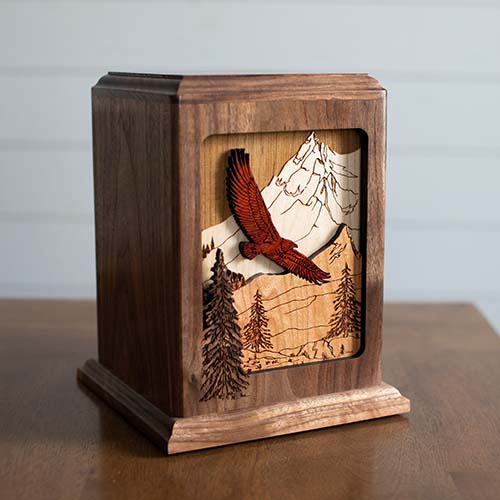
Whether buried, scattered, or kept at home, most people choose a cremation urn to hold the cremains.
You can, of course, use the plastic temporary urn provided by the funeral home. You can also use just about any container imaginable, from coffee tins to old wine bottles to fishing tackle boxes.
But most people choose a lovely, elegant, and classy cremation urn to show honor to their loved one’s remains. These attractive containers are designed to hold the cremains in a dignified way, worthy of display.
Browse some of the most popular cremation urns available to the public here. And yes, the funeral home or cemetery is required by law to accept and use any urn of your choice – you don’t have to buy the urn from them.
3. Scattering
Another popular option is to scatter the cremains. Scattering offers a lot of flexibility; you can scatter immediately after the cremation or years down the road, in your backyard or out in the woods, at sea or in a scattering garden at the cemetery.
There are many scattering urns designed to make the process easy, but you can also use the original container or just about any urn with a lid.
Related: Scattering Ashes: Everything You Need to Know
4. Cremains in Glass
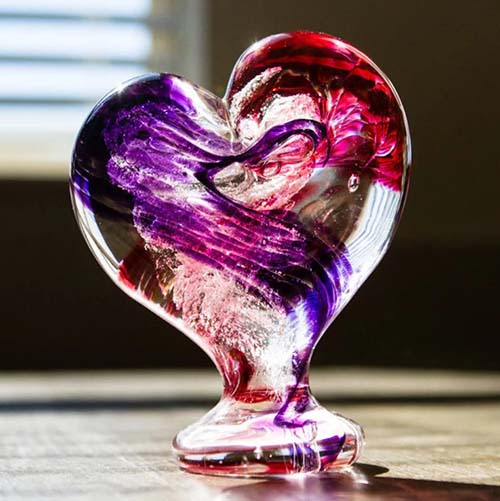
Here’s a unique way to memorialize your loved one: Commission an artist to mix the ashes into glass, crafting a keepsake that is both beautiful and meaningful.
Glass is just one of many choices. People mix cremains into all sorts of creative mediums to form keepsake memorials, from tattoo ink to ashes in diamonds.
5. Cremation Jewelry
Cremation jewelry includes necklaces, rings, and bracelets that hold a tiny amount of cremains inside a small chamber. You’ll love finding the perfect accessory to keep your loved one close to your heart.
Read Next: 68 Interesting Things You Can Do with Cremation Ashes
Pin It



